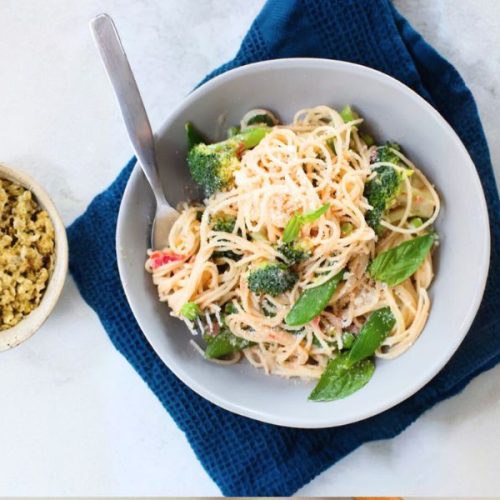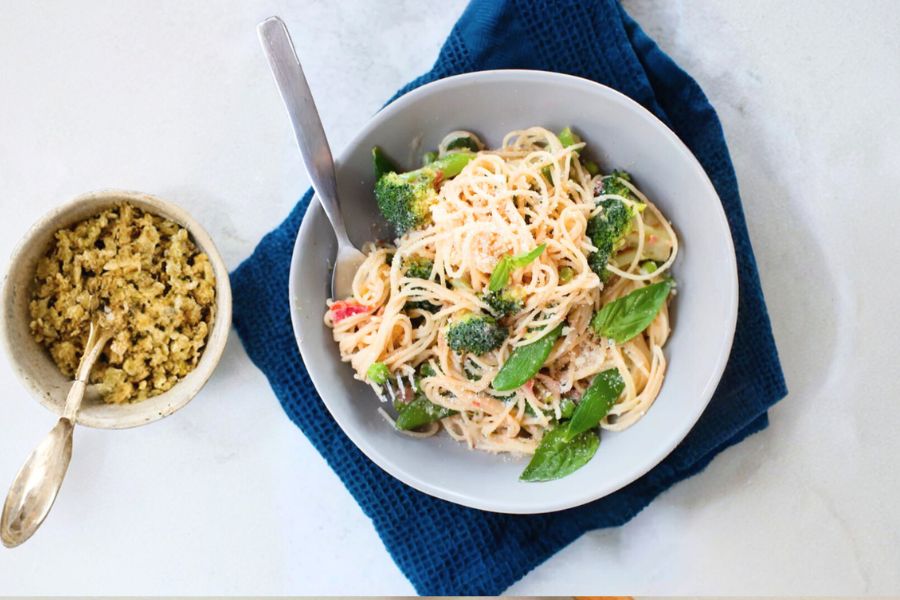This Classic Pasta Primavera is a vibrant, garden-fresh dish that balances comfort and nutrition beautifully.
Packed with colorful vegetables like broccoli, asparagus, zucchini, and snow peas, it delivers a powerhouse of vitamins, antioxidants, and fiber that promote healthy digestion and long-lasting energy.
The Parmesan and cream sauce adds a touch of indulgence without overwhelming the fresh flavors, while the pasta provides a satisfying base. Many of the vegetables in this dish are naturally low in carbs yet rich in plant-based protein, making it a great option for those seeking lighter, nutrient-dense meals.
Its quick cooking time and simple prep make it perfect for weeknights, and leftovers reheat well for easy lunches.

This recipe’s versatility allows you to swap in seasonal produce, making it a year-round favorite that’s both wholesome and delicious.
Must-Have Tools for Perfect Results
All-Clad Stainless Steel Stockpot
Ideal for blanching vegetables and boiling pasta, its even heat distribution ensures consistent cooking for both steps in the recipe. A must-have for soups, stews, and pasta dishes year-round.
OXO Good Grips Colander
.Perfect for quickly draining blanched vegetables and pasta without mess. Its sturdy base and easy-grip handles make it a dependable kitchen staple.
Wüsthof Classic Chef’s Knife
.Essential for precise chopping of zucchini, tomatoes, and herbs, this razor-sharp blade saves prep time and boosts safety and control.
All-Clad Stainless Steel Sauté Pan
The best choice for creating the delicate cream sauce and tossing pasta with vegetables evenly. Excellent for everything from stir-fries to pan sauces.
Microplane Premium Zester/Grater
Ideal for freshly grating Parmesan, releasing maximum flavor and texture. Also great for zesting citrus and grating spices.

30-Minutes Pasta Primavera
Equipment
- 1 Large Stockpot
- 1 Colander
- 1 large bowl (for ice bath)
- 1 Chef’s Knife
- 1 Large Saute Pan
- 1 Wooden Spoon or Silicone Spatula
- 1 Microplane Zester
Ingredients
- 1 heaping cup broccoli florets
- 4 asparagus spears trimmed and cut into 1-inch pieces
- 1/2 cup snow peas
- 8 oz 1/2 pound angel hair pasta or spaghetti
- 4 tbsp unsalted butter
- 3 cloves garlic minced
- 1 small zucchini diced
- 3 Roma or other paste tomatoes, seeded and diced
- 1/4 cup chicken or vegetable stock
- 1/2 cup heavy cream
- 1/2 cup peas fresh or frozen
- 1/2 cup grated Parmesan cheese
- 12 fresh basil leaves chopped
- Kosher salt to taste
Instructions
- Prepare the Ice Bath: Fill a large bowl with cold water and plenty of ice cubes. This will be used to “shock” the vegetables after blanching, helping them retain their bright color and crisp texture. Set the bowl aside near your cooking area so it’s ready when needed.
- Blanch the Vegetables: Bring a large stockpot of well-salted water to a rolling boil — it should taste almost like seawater. Add the broccoli florets and cook for 1 minute. Stir in the asparagus pieces and cook for another minute, then add snow peas for a final 30 seconds. Immediately transfer all vegetables to the prepared ice bath to stop cooking, then drain well in a colander.
- Cook the Pasta: In the same pot of water used for blanching (or fresh water if preferred), return to a boil. Add pasta and cook according to package instructions until al dente, stirring occasionally to prevent sticking. Reserve 1/2 cup of the cooking water, then drain pasta thoroughly.
- Sauté the Aromatics: In a large sauté pan over medium heat, melt the butter until foamy. Add minced garlic and cook for 30–45 seconds, stirring often, until fragrant but not browned. Stir in diced zucchini and cook for 2–3 minutes until slightly softened. Add diced tomatoes and cook for 1 more minute, just until they begin to release their juices.
- Create the Sauce: Pour the stock into the pan, scraping the bottom to release any flavorful bits. Stir in the heavy cream and bring to a gentle simmer. Reduce heat to medium-low, then add peas and blanched vegetables, tossing gently to coat everything evenly in the sauce.
- Combine and Finish: Add the cooked pasta directly to the pan, tossing with tongs to incorporate it into the sauce. If the mixture seems too thick, add a splash of reserved pasta water until desired consistency is reached. Sprinkle in Parmesan cheese and fresh basil, tossing again until the cheese melts slightly and the pasta is fully coated. Taste and adjust with kosher salt if needed.
- Serve: Transfer pasta to warmed serving bowls or plates. Top with extra Parmesan and basil if desired, and serve immediately for the best texture and flavor.
Notes
- Use the freshest vegetables possible for the best flavor and texture; seasonal produce makes a big difference.
- Don’t skip the ice bath — it locks in color, stops overcooking, and keeps veggies crisp-tender.
- For a lighter version, replace heavy cream with half-and-half or a mix of milk and Greek yogurt (added off the heat).
- Leftovers can be stored in an airtight container in the refrigerator for up to 3 days; reheat gently with a splash of stock or water.
- This dish is highly adaptable — try adding mushrooms, bell peppers, or spinach for variety.
Chef’s Secrets for Pasta Success
The key to an unforgettable Pasta Primavera lies in timing and freshness.
Start with the highest quality vegetables you can find — preferably seasonal — to maximize flavor and nutrition.
Blanching the vegetables separately before adding them to the sauce ensures they retain their vibrant color and crisp bite, while also preventing overcooking.
Use a generous amount of salt in your pasta water; this is your first opportunity to season the dish from within.
When making the cream sauce, keep the heat at a gentle simmer to avoid curdling and to let flavors meld smoothly.
Finally, always finish cooking the pasta in the sauce, allowing it to absorb the flavors for a restaurant-quality result.
Serving Suggestions for Maximum Enjoyment
Pasta Primavera is versatile enough to shine as both a main course and a side dish.
For a balanced meal, pair it with a simple green salad dressed in lemon vinaigrette, or serve alongside garlic bread for a more indulgent experience.
A crisp white wine, such as Pinot Grigio or Sauvignon Blanc, complements the dish’s creamy, herb-infused sauce beautifully.
For a protein boost, top with grilled chicken, shrimp, or even pan-seared tofu for a vegetarian twist.
Garnish with extra Parmesan and fresh basil leaves just before serving to add an aromatic, visually appealing finish.
Storage Tips for Fresh Flavor
To keep leftovers tasting their best, transfer cooled pasta to an airtight container and refrigerate for up to 3 days.
When reheating, do so gently over medium-low heat on the stovetop or in short microwave bursts, adding a splash of water or stock to loosen the sauce.
Avoid freezing this dish, as the cream-based sauce can separate and the vegetables may lose their desirable texture.
If you plan on making it ahead, consider cooking the vegetables and pasta separately, then combining them with the sauce just before serving for the freshest results.
Frequently Asked Questions and Answers
1. Can I use whole wheat pasta instead of regular pasta?
Yes, whole wheat pasta works well and adds extra fiber. Just note that it has a slightly nuttier flavor and firmer texture, so adjust your cooking time to ensure it reaches al dente.
2. What can I substitute for heavy cream?
You can use half-and-half for a lighter version, or a combination of milk and Greek yogurt for extra creaminess. For a dairy-free option, try coconut cream or unsweetened oat cream.
3. Can I make this recipe vegan?
Absolutely. Replace the butter with olive oil, use plant-based cream, and substitute vegan Parmesan. The flavors will remain rich and satisfying.
4. How do I prevent my vegetables from overcooking?
Blanching in boiling water followed by an ice bath is the best method. This stops cooking instantly, locking in both color and texture. Add vegetables to the sauce only at the end to warm them through.
5. Is this dish good for meal prep?
Yes, but for the best texture, store pasta and sauce separately, combining them just before reheating. This prevents the pasta from absorbing too much sauce and becoming mushy.
This recipe has been adapted and simplified from the original version by simplyrecipes. We’ve refined the steps for a smoother cooking experience and added helpful notes, nutrition insights, and essential kitchen tools to make it even easier for home cooks.

